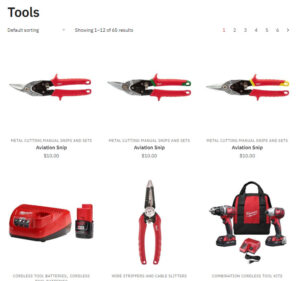
An effective B2B eCommerce catalog is the backbone of your whole eCommerce system for any wholesale distributor or supplier. In this article, I will share with you the important building blocks behind creating a profit-generating online catalog that will keep you ahead of your competitors.
In this article:
- The reasons why many sellers are underperforming online
- Being slow to adapt will cost you
- Essential tips on how to build an effective eCommerce catalog
- Facts and trends
- Looking ahead into the future

My name’s Anton Pachkine, and I run FinestShops, where we have built, upgraded, and optimized eCommerce systems for our clients since 2003. If you feel confused or unsure of any of the points made, please don’t hesitate to get in touch for more information.
The reasons why many sellers are underperforming online
Customer expectations have risen to excessive levels in the digital age. It’s not enough to publish a link to your PDF brochure. Your B2B eCommerce catalog has to be comprehensive to provide potential buyers with enough information and functionality to persuade them to request a quote or place an order with you.
However, many wholesalers and suppliers operate with an online catalog that’s outdated or non-existent. Because of this, potential buyers, dealers, and salespeople are often forced to go through the tedious process of contacting the business or another department for basic or specific information, decreasing the chances of a sale from happening.
To make matters worse, these outdated online catalogs make it difficult for Google to index product pages in their system, which punishes the business with a lower ranking on their search results. Since 74% of buyers research online before placing an order, sellers must run an online catalog that meets the current demands.
It’s fundamental to upgrade your website right now. Delaying the process will create a higher barrier to entry in the future because generating any authority on Google takes time. After the upgrade, you’ll have to wait at least six months before you gain any visibility on Google’s search results.
Being slow to adapt will cost you
There will be competitors in your industry who have already integrated an online catalog into their website, allowing Google to index the products and recommend them in the search results to the buyers.
The longer you wait, the harder it will be for you to achieve a higher search engine optimization score than your competitors, allowing them to gain a larger market share. This is important because if your competitors are visible on Google and you’re not, who do you think will generate more sales and higher profits? It’s unlikely to be you.
B2B sellers must act now before the barrier to entry is too high. The only challenge is creating a powerful eCommerce catalog that will be highly useful for your customers, buyers, dealers, and salespeople, as well as give you an advantage in the online search results.
Let me show you how.
Essential tips on how to build an effective eCommerce catalog
Categorize your products to make them more accessible
Your objective is to create a comprehensive online product catalog that is easy to navigate. To achieve this, divide your products into logical categories and set up a separate page for every product so that Google and other search engines can find and index each product separately.
Make sure your catalog is mobile friendly
Most websites nowadays receive over 80% of visitors from mobile devices. Your website and product catalog is not an exception, and most users will browse it from a phone or tablet, so you have to ensure it provides an optimal experience on any device.
Use your catalog to get more inquiries from your potential buyers
In your B2B eCommerce catalog, make it easy for a visitor to apply for a business account, ask questions, or request a quote. To achieve this, including a “Business registration” link or a banner which takes visitors to an application form and “Ask a question about this product” on every product page.
Maximize conversion by providing detailed information about your products
The more information you share about a product, the more likely a customer will be interested in buying and keep buying from you. Here are some examples of how to achieve specificity in your B2B eCommerce catalog:
- Competitive advantages
- Detailed description
- Complete specification
- Eye-catching high-resolution photos
- Cutouts to show why your product is superior
- PDF schematics with dimensions
- PDF user manuals
- Maintenance tips
- Demo, installation, repair, and maintenance videos
- Installation examples and photos in use
- Shipping, return, and warranty policies
Enhance credibility through testimonials
Displaying customer testimonials will add trust and increase the conversion rate. It works well for retail and business sales because you still sell to a human buyer or purchasing agent. Tip: hide the rating section with 0 ratings and reviews on the product pages and set up an automated review reminder to collect the reviews. Real user reviews are one of the main components of a well-performing e-commerce catalog.
Now, I know we’ve covered a lot of ground here…so if you’re confused about any of the points mentioned, or would like additional information on what’s already been said, don’t hesitate to book a call in my calendar.
B2B facts and trends
- 74% of buyers do research online before making an offline purchase
- 42% of the online research is done on mobile devices
- 86% of buyers prefer using self-service tools rather than calling a sales representative
*according to Forrester Research
Looking ahead into the future
The world of eCommerce is advancing at a rapid rate. Every day businesses are adapting their service to meet or exceed the demands placed on them by customers, buyers, dealers, and their own sales team. The eCommerce catalog is a mandatory asset every seller must have to remain competitive.
Setting up an online catalog now will put you on the front foot to achieve a stronger SEO ranking and enhance the buyer’s experience.
So what does this mean? More sales, more profits, and more growth.
A powerful online catalog is one part of our eCommerce Signature System. It’s built to enable Google to crawl and index your product pages with ease and convert any new visitors on your website into a buyer. This gives you the foundation needed to overtake your competitors on Google’s search results, attract more customers to your website and grow your business.
